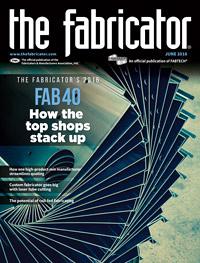Senior Editor
- FMA
- The Fabricator
- FABTECH
- Canadian Metalworking
Categories
- Additive Manufacturing
- Aluminum Welding
- Arc Welding
- Assembly and Joining
- Automation and Robotics
- Bending and Forming
- Consumables
- Cutting and Weld Prep
- Electric Vehicles
- En Español
- Finishing
- Hydroforming
- Laser Cutting
- Laser Welding
- Machining
- Manufacturing Software
- Materials Handling
- Metals/Materials
- Oxyfuel Cutting
- Plasma Cutting
- Power Tools
- Punching and Other Holemaking
- Roll Forming
- Safety
- Sawing
- Shearing
- Shop Management
- Testing and Measuring
- Tube and Pipe Fabrication
- Tube and Pipe Production
- Waterjet Cutting
Industry Directory
Webcasts
Podcasts
FAB 40
Advertise
Subscribe
Account Login
Search
A ticket of entry to laser cutting
Company takes a new approach to laser cutting technology
- By Tim Heston
- July 5, 2016
- Article
- Laser Cutting
According to the U.S. Census, the vast majority of manufacturing in this country occurs in small businesses—very small businesses. This includes metal fabricating. When you look at the fabricated metal products arena, as counted by the 2012 U.S. Economic Census, you will see that more than 67 percent of establishments have fewer than 20 employees.
Alexander Krasnov is betting that many haven’t had the financial resources for most conventional laser cutting machines, but if they could afford it, they’d buy one. According to Krasnov, his company is offering a laser cutting machine they can afford, adding that the system’s cost is comparable to a high-definition plasma system or waterjet.
In the 1990s and early 2000s he received several patents in the U.S., Russia, and Europe on a new CO2 laser, which takes a new approach to gas excitation. In 2010 he and his brother Yuri Krasnov launched Alkras, a company in Milford, Mass., to commercialize the technology.
In 2013 the company exhibited at the FABTECH® show in Chicago. One of the 1,500-W units it showed at the booth weighed only 65 pounds, and its 3,000-W unit weighed less than 120 lbs. According to company literature, its 2-kW laser has cut 1-mm-thick carbon steel at more than 14 meters per minute, and 3-mm-thick material at more than 5 MPM. Being of the CO2 variety, the laser can also handle many nonmetals.
The laser represented something new, but unfortunately, many of the small companies Alkras was trying to reach weren’t interested in buying a laser and building or retrofitting a table. So this year the company released its first turnkey laser cutting systems with an X-Y table, RF power supply, chiller, and control system. They are available with laser powers from 700 to 2,500 W.
According to the company, beam delivery requires only one or three mirrors, depending on the table configuration. Making this possible is the laser itself, which is small enough to fit on the machine gantry.
As Alexander explained, the laser has a unique internal cavity design inside the optical resonator. The design also incorporates new approaches to where exactly the excitation of the gas molecules occurs. He added that the design ultimately creates an optical efficiency of between 16 and 17 percent.
Another factor is the beam mode characteristics. The Alkras system uses an “A” mode beam profile. In this, the beam uses a high amount of energy in the center; moving out toward the end of the beam profile, the energy quickly decreases and, near the edge of the beam diameter, increases again dramatically before rapidly falling toward zero.
According to the company, the high energy at the beam’s center helps penetrate the material quickly, while the high energy near the edge of the beam diameter helps produce a clean cut. “As a result of the laser in ‘A’ mode, 95 percent of the beam’s energy goes directly to the cutting kerf,” Krasnov said.
Photo provided by Alkras LLC, 774-230-9956, www.alkras.com.n image is not displayed, click the hyperlinked figure number to view it
About the Author

Tim Heston
2135 Point Blvd
Elgin, IL 60123
815-381-1314
Tim Heston, The Fabricator's senior editor, has covered the metal fabrication industry since 1998, starting his career at the American Welding Society's Welding Journal. Since then he has covered the full range of metal fabrication processes, from stamping, bending, and cutting to grinding and polishing. He joined The Fabricator's staff in October 2007.
subscribe now

The Fabricator is North America's leading magazine for the metal forming and fabricating industry. The magazine delivers the news, technical articles, and case histories that enable fabricators to do their jobs more efficiently. The Fabricator has served the industry since 1970.
start your free subscription- Stay connected from anywhere

Easily access valuable industry resources now with full access to the digital edition of The Fabricator.

Easily access valuable industry resources now with full access to the digital edition of The Welder.

Easily access valuable industry resources now with full access to the digital edition of The Tube and Pipe Journal.
- Podcasting
- Podcast:
- The Fabricator Podcast
- Published:
- 04/16/2024
- Running Time:
- 63:29
In this episode of The Fabricator Podcast, Caleb Chamberlain, co-founder and CEO of OSH Cut, discusses his company’s...
- Industry Events
16th Annual Safety Conference
- April 30 - May 1, 2024
- Elgin,
Pipe and Tube Conference
- May 21 - 22, 2024
- Omaha, NE
World-Class Roll Forming Workshop
- June 5 - 6, 2024
- Louisville, KY
Advanced Laser Application Workshop
- June 25 - 27, 2024
- Novi, MI
































